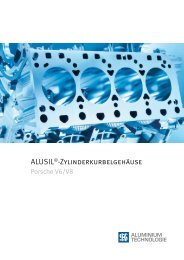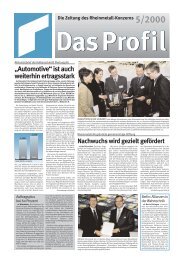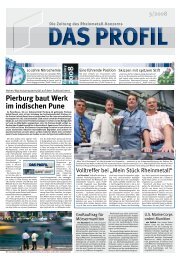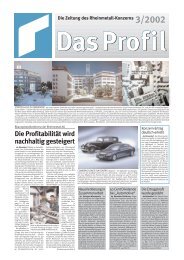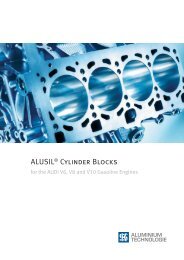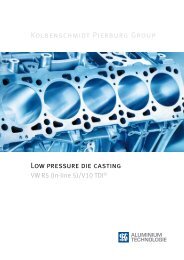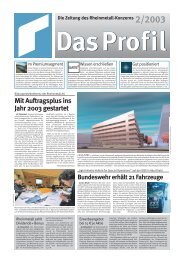High-pressure Die Cast Cylinder Blocks Made of ... - KSPG AG
High-pressure Die Cast Cylinder Blocks Made of ... - KSPG AG
High-pressure Die Cast Cylinder Blocks Made of ... - KSPG AG
You also want an ePaper? Increase the reach of your titles
YUMPU automatically turns print PDFs into web optimized ePapers that Google loves.
<strong>High</strong>-<strong>pressure</strong> <strong>Die</strong> <strong>Cast</strong> <strong>Cylinder</strong><br />
<strong>Blocks</strong> <strong>Made</strong> <strong>of</strong> Aluminium<br />
<strong>High</strong>ly Efficient Solution Specifically<br />
for Passenger Car In-line Engines
1. Aluminium cylinder blocks support light weight<br />
design<br />
<strong>Cast</strong>ings <strong>of</strong> aluminium are making an evermore significant<br />
contribution to leveraging light construction potentials in<br />
modern passenger cars. The heaviest individual component,<br />
the cylinder block, has meanwhile taken on a key role. If we<br />
consider the enormous number <strong>of</strong> in-line engines produced,<br />
especially four-cylinder and three-cylinder engines, but increasingly<br />
also six-cylinder engines in in-line and V arrangement,<br />
the cost/benefit aspect must have absolute priority.<br />
The replacement <strong>of</strong> grey cast iron with aluminium for cylinder<br />
blocks therefore presupposes low-cost concepts.<br />
2. Concept diversity for aluminium cylinder blocks<br />
Contrary to the cylinder blocks produced so far, mostly made<br />
from grey cast iron based on a uniform concept which already<br />
incorporates the cylinder bore surfaces when a perlitic<br />
structure configuration is chosen, there are many diverse<br />
options in the case <strong>of</strong> aluminium. These relate to the concept<br />
modules <strong>of</strong> type or cylinder block design, alloy, casting<br />
method and cylinder bore surface, in which case manifold<br />
incompatibilities have to be considered. The overriding aspect<br />
is therefore the compatibility <strong>of</strong> the concept modules.<br />
2<br />
Fig. 1: <strong>High</strong>ly efficient solution specifically for passenger car in-line engines<br />
A further constraint for the concepts which are viable in principle<br />
results for concrete engine development projects from<br />
the targets and general specifications with respect to the engine<br />
function, elemental engine characteristics (number and<br />
arrangement <strong>of</strong> cylinders), annual outputs, costs <strong>of</strong> castings<br />
and engine systems, optimization potential, environmental<br />
aspects and recyclability. This situation has led to a large<br />
number <strong>of</strong> marketable concepts.<br />
3. Aluminium cylinder blocks and high-<strong>pressure</strong><br />
die casting method<br />
3.1 Economic aspect<br />
From the economic aspect, for mass produced engines, high<strong>pressure</strong><br />
die casting is mainly competing with the highly<br />
automated sand core package process whose cycle time is<br />
not bound to the solidification. In the highly competitive,<br />
cost-sensitive market segment <strong>of</strong> the three-cylinder and<br />
four-cylinder engines, however, high-<strong>pressure</strong> die casting is<br />
unrivalled in cost-effectiveness thanks to outstanding productivity<br />
based on appropriate component design. Currently,<br />
worldwide large quantities <strong>of</strong> four-cylinder engine blocks <strong>of</strong><br />
aluminium are made by this method. The aluminium high<strong>pressure</strong><br />
die casting method is now also in the process <strong>of</strong><br />
establishing itself in the six-cylinder engine business.
Applying the latest high-<strong>pressure</strong> die casting technology,<br />
aluminium cylinder blocks are produced whose properties<br />
are hardly inferior to high-grade low-<strong>pressure</strong> die castings or<br />
sand core castings and which boast a decisive cost benefit in<br />
bulk production. Its attractiveness is the greater the smaller<br />
the component and the higher the product output are. Innovative<br />
approaches with new die concepts to increase the tool<br />
life and further reduction <strong>of</strong> the cycle time, not least through<br />
intensive die cooling, additionally contribute to curbing production<br />
costs.<br />
3.2 <strong>High</strong>-<strong>pressure</strong> die casting technology<br />
As far as the frequently applied conventional high-<strong>pressure</strong><br />
die casting method is concerned, it should be mentioned<br />
that in light <strong>of</strong> today’s constantly increasing requirements it<br />
<strong>of</strong>ten fails to yield the necessary component quality. What<br />
is more, conventional high-<strong>pressure</strong> die cast cylinder blocks<br />
made <strong>of</strong> aluminium exhibit a relatively high degree <strong>of</strong> porosity<br />
which prohibits the application <strong>of</strong> solution annealing and<br />
<strong>of</strong> cylinder bore coating. To achieve the necessary static and<br />
dynamic strengths, however, evermore refined high-<strong>pressure</strong><br />
die casting processes and new production processes<br />
are essential. In order to remedy this situation, KS Aluminium-Technologie<br />
employs techniques like an optimally degassed<br />
melt, an efficiently evacuated high-<strong>pressure</strong> die as<br />
well as residue-free lubricants for the shot plunger in the die<br />
filling chamber. Further improvements are achieved through<br />
innovations like optimized high-<strong>pressure</strong> die spraying technique<br />
combined with wax-free spraying agent, long-life tool<br />
coating as well as uniform, intensive cooling <strong>of</strong> the die. The<br />
basic prerequisite for high strength and its enhancement is a<br />
low degree <strong>of</strong> porosity at the quality level <strong>of</strong> low-<strong>pressure</strong> die<br />
casting. In addition, this enables the cylinder bore surfaces<br />
to be coated, in high-<strong>pressure</strong> die casting as well.<br />
3.3 Design features<br />
For cylinder blocks, the weight reduction potential inherent<br />
in material substitution ranges from 35 %, expected <strong>of</strong> aluminium<br />
used in passenger-car diesel engines as a minimum<br />
requirement, appr. 50 %. <strong>High</strong>-<strong>pressure</strong> die casting allows<br />
for extremely reduced wall thicknesses and thus <strong>of</strong>fers especially<br />
favourable conditions for light construction. In combination<br />
with its near-net-shape benefits, the weight can be reduced<br />
by eight to 15 % in comparison with low-<strong>pressure</strong> die<br />
casting where no, or only a water jacket sand core is used.<br />
For the conventional high-<strong>pressure</strong> die casting method,<br />
mouldability in steel is a must and the open-deck design<br />
is unavoidable therefore. But today, in general it is more<br />
readily accepted for aluminium cylinder blocks. Distinctly<br />
reduced water jacket depth and co-moulded cylinder bores<br />
have created an option besides the conventional open deck<br />
Fig. 2: Open-deck and closed-deck design, shown with one and the same high-<strong>pressure</strong> die cast aluminium cylinder block (left);<br />
high-<strong>pressure</strong> die casting resistant water jacket sand core made by the warm-box process with the application <strong>of</strong> a special wash (right)<br />
3
which features a sufficiently stiff cylinder area even without<br />
a closed deck, meeting the requirements <strong>of</strong> most in-line engines.<br />
But the open-deck design limits the component thickness,<br />
specifically in the upper cylinder area. For small highduty<br />
engines – especially passenger-car DI diesel engines<br />
– this handicap may potentially prevent the implementation<br />
<strong>of</strong> low-cost high-<strong>pressure</strong> die-cast cylinder blocks and even<br />
prompt a look back to grey castings.<br />
In light <strong>of</strong> this situation, KS Aluminium-Technologie has for<br />
many years already been studying ways to find suitable technologies<br />
for producing lost water jacket sand cores which<br />
can be used to implement a closed-deck design in a reliable<br />
high-<strong>pressure</strong> die casting process (Fig. 1). On the one hand,<br />
the core should be <strong>pressure</strong>-pro<strong>of</strong> and also temperatureresistant<br />
for a defined time and additionally cope with the<br />
high flow velocity <strong>of</strong> the liquid metal. On the other hand, the<br />
core removal should be unproblematic. Furthermore, lowcost<br />
sands, binders and release agents are required which<br />
should be easy to handle in order to warrant process stability.<br />
This difficult trade-<strong>of</strong>f has meanwhile been accomplished<br />
satisfactorily on the basis <strong>of</strong> a “warm box” core with customized<br />
release agents. It is viable now to <strong>of</strong>fer the closed-deck<br />
option in the high-<strong>pressure</strong> die casting mode at acceptable<br />
4<br />
Fatigue strength [MPa]<br />
140<br />
120<br />
100<br />
80<br />
60<br />
40<br />
20<br />
0<br />
Competitor data<br />
R = -1: reversed stress<br />
R = 0: tumescent tensile stress<br />
Regular HPDC (as cast)<br />
Vacuum support<br />
incremental cost for specific series applications, e.g. for<br />
boosting the performance <strong>of</strong> standard engines in open-deck<br />
design.<br />
3.4 Properties<br />
The integral optimization <strong>of</strong> the influencing process steps<br />
mentioned in 3.2 also enables extremely low-pore castings<br />
to be produced by the high-<strong>pressure</strong> die casting method.<br />
Thanks to intensive die cooling, the liquid aluminium will solidify<br />
very fast, not only in the thin-walled areas but also in<br />
the thick bulkheads. The application <strong>of</strong> high <strong>pressure</strong> makes<br />
for very quick heat dissipation. Accordingly, the microstructure<br />
is very dense, particularly near the surface. On account<br />
<strong>of</strong> the quick gate freeze-<strong>of</strong>f which is inherent in the principle<br />
applied, the possibilities <strong>of</strong> supplementary feeding are limited,<br />
however.<br />
The cylinder blocks made by high-<strong>pressure</strong> die casting excel<br />
by a highly fine-grained microstructure which, in combination<br />
with low porosity, constitutes the basis for good strength<br />
properties. These high-grade castings lend themselves to full<br />
heat treatment. The attainable strength levels are very close<br />
to those <strong>of</strong> low-<strong>pressure</strong> die and sand castings, even in regard<br />
to their dynamic characteristics. (assuming local chill<br />
moulds in the latter case!) (Fig. 2).<br />
Vacuum<br />
Vacuum + strength<br />
increasing heat treatment<br />
Fig. 3: Dynamic strength increasing steps in combination with suitable optimization measures for high-<strong>pressure</strong> die castings<br />
Vacuum<br />
+ optimized casting process<br />
+ strength increasing<br />
heat treatment
3.5 <strong>Cylinder</strong> bore surface<br />
Reinforcing the cylinder bores is indispensable because the<br />
hypoeutectic alloy options which are suitable for high-<strong>pressure</strong><br />
die casting lack the necessary tribological properties.<br />
For this purpose, a multitude <strong>of</strong> liners are available (Fig. 3).<br />
The lowest cost option consists in solving the cylinder bore<br />
surface problem in the case <strong>of</strong> high-<strong>pressure</strong> die cast cylinder<br />
blocks by means <strong>of</strong> cast-in liners may <strong>of</strong> grey cast iron.<br />
However, the use <strong>of</strong> cylinder bore liners imparts on the cylinder<br />
block a heterogeneous character. When liners are cast in,<br />
with the high-<strong>pressure</strong> die casting method the smallest gaps<br />
are produced between liner and overcast, which is reflected<br />
in comparatively good equivalent thermal conductivity values.<br />
According to the present state <strong>of</strong> the art, liners made <strong>of</strong><br />
suitable aluminium materials can anyway only be cast in by<br />
high-<strong>pressure</strong> die casting as they have to rely on extremely<br />
short solidification times because <strong>of</strong> the melting-through<br />
risk. The outer face area fusion <strong>of</strong> aluminium liners or <strong>of</strong> aluminium-coated<br />
grey cast liners with the aluminium overcast<br />
can meanwhile be accomplished satisfactorily. A mechanical<br />
interlock is feasible in combination with rough-as-cast liners<br />
made <strong>of</strong> grey cast iron (BMI).<br />
a b c d<br />
e f g<br />
Fig. 4: <strong>Cylinder</strong> bore liners <strong>of</strong> various designs for casting into<br />
high-<strong>pressure</strong> die cast cylinders and for shrinking in or inserting<br />
<strong>Cast</strong>-in liners are subject to residual stresses that are difficult<br />
to control. Another problem is inhomogeneity as a result <strong>of</strong><br />
casting tolerances and deformation. So it takes substantial<br />
development efforts to control multifactor-conditioned cylinder<br />
bore distortion problems with potential functional drawbacks,<br />
especially in long-term operation.<br />
Monolithic and quasi-monolithic concepts with their inherent<br />
advantages (see also product information brochure “Low-<br />
<strong>pressure</strong> <strong>Die</strong> <strong>Cast</strong> <strong>Cylinder</strong> <strong>Blocks</strong>”, for example) are the only<br />
option to readily comply with the frequent request for extremely<br />
compact cylinder units (minimal land width between<br />
cylinders = minimal cylinder spacing) or for maximum cylinder<br />
bore at a given cylinder spacing.<br />
With LOKASIL ® , KS Aluminium-Technologie has developed an<br />
equivalent concept for the high-<strong>pressure</strong> die casting method<br />
with local silicon concentration combined with a suitable<br />
honing process for mechanical exposure <strong>of</strong> the silicon<br />
grains. With PORSCHE as pilot customer, the series launch <strong>of</strong><br />
LOKASIL ® cylinder blocks was achieved with the engines<br />
<strong>of</strong> Boxster and <strong>of</strong> the water-cooled 911 (identical cylinder<br />
blocks in several bore/swept volume variants). The local<br />
concentration <strong>of</strong> silicon particles in the cylinder bores with<br />
MMC microstructure<br />
Ceramic fiber –<br />
particle preform<br />
12.5 micron<br />
Bulkhead / main bearing<br />
reinforcement<br />
Fig. 5: MMC bulkhead reinforcement with aluminium bedplate<br />
and optionally also for an aluminium cylinder block<br />
5
LOKASIL ® is a substitute for the normally cast in massive<br />
grey cast liners, thus contributing to weight reduction. The<br />
quasi-monolithic component character <strong>of</strong>fers a myriad <strong>of</strong><br />
benefits ranging from more compact longitudinal component<br />
dimensions through more efficient thermal relief to reduced<br />
cylinder distortion. With the LOKASIL ® Ib version, a low-cost<br />
preform <strong>of</strong> silicon particles and certain ceramic fibres is<br />
available which is competitive with grey cast liners (Fig. 4). It<br />
ensures better infiltration and increases the strength <strong>of</strong> the<br />
composite. Further decisive progress in process engineering<br />
was achieved with the possibility to cast LOKASIL ® cylinder<br />
blocks on real-time controlled high-<strong>pressure</strong> die casting machines<br />
with absolute process reliability.<br />
In order to meet the demand for advanced, downsized cylinder<br />
blocks, it is indispensable from the technical aspect to<br />
create outstanding tribological conditions. Internal friction<br />
loss measurements have shown a clear advantage <strong>of</strong> ironcoated<br />
bore surfaces compared to aluminium bore surfaces.<br />
That is why for some years already KS Aluminium-Technologie<br />
has focused on this issue and now resorts to a coating process<br />
with preceding mechanical roughing up. The sprayed-on<br />
iron coat is machined by means <strong>of</strong> a honing process purposeadjusted<br />
to the individual cylinder block and its coating to<br />
obtain the tribologically perfect piston running clearance.<br />
6<br />
Temperature-related main bearing clearance<br />
Increase <strong>of</strong> main bearing<br />
clearance [%]<br />
100<br />
80<br />
60<br />
40<br />
20<br />
0<br />
Aluminium<br />
Modular inserts<br />
Al/MMC<br />
4. Bedplate<br />
Fig. 6: Compensation <strong>of</strong> temperature-related increase <strong>of</strong> main bearing clearance (left)<br />
Weight saving potential inherent in MMC bulkhead reinforcement (reight)<br />
<strong>Cylinder</strong> blocks made <strong>of</strong> aluminium alloys are differentiated<br />
according to various designs. Where stiffness is the most important<br />
characteristic <strong>of</strong> a cylinder block, a bipartite design<br />
is chosen. In this case, the cylinder block is split horizontally<br />
at the level <strong>of</strong> the crankshaft bearing axis. The upper part<br />
normally continues to be called cylinder block (more correctly<br />
it would in this case have to be referred to as cylinder block<br />
upper section) whilst the lower part is named bedplate.<br />
If the bedplate is produced by high-<strong>pressure</strong> die casting, the<br />
secondary alloy AlSi9Cu3 is used, in which case so-called<br />
“bearing caps” made <strong>of</strong> nodular cast iron are integrally cast<br />
in. The latter serve to control the main bearing clearance in<br />
the operating temperature range (acoustics, oil pump delivery<br />
rate/oil pump losses) and to stiffen the bulkhead system.<br />
The cast-in inserts consist <strong>of</strong> two bosses with a bow-shaped<br />
connector. In the case <strong>of</strong> V cylinder blocks, two bosses can<br />
be arranged in parallel. To the side <strong>of</strong> the bosses and between<br />
them underneath the bow, undercut and open-worked<br />
anchors are arranged which provide for positive coupling<br />
with the adjoining aluminium. As the main bearings are narrow,<br />
the inserts are frequently cut free in large areas due to<br />
the freewheeling <strong>of</strong> the crankshaft. That is why a solid anchor<br />
system is <strong>of</strong> special importance. A crank scraper/oil separator<br />
wall can be integrated into the bedplates, designed to<br />
Weight saving potential<br />
Weight saving potential [kg]<br />
5<br />
4<br />
3<br />
2<br />
1<br />
0<br />
I4 I5 I6 V6 V8 V12<br />
Engine design, amount <strong>of</strong> cylinders
oute the oil selectively from the crankcase to the oil sump<br />
and to separate it at the same time from the crankcase in<br />
order to minimize oil foaming.<br />
The bearing caps made <strong>of</strong> nodular cast iron can also be replaced<br />
by MMC bulkhead reinforcements for the purpose <strong>of</strong><br />
weight reduction. The gap-free composite with the adjoining<br />
aluminium additionally prevents leaks in the lube oil supply<br />
for the main bearings. The composite material is tailored<br />
such that its coefficient <strong>of</strong> thermal expansion is only slightly<br />
higher than that <strong>of</strong> the steel or nodular cast iron <strong>of</strong> the crankshaft.<br />
As a result, this technology – which is ahead <strong>of</strong> the current<br />
state <strong>of</strong> the art – can even achieve full compensation for<br />
the significant thermal expansion <strong>of</strong> aluminium if the composite<br />
material is also applied to the cylinder block (upper<br />
part) (Figs. 5 and 6). In this way, bearing gap losses (oil pump<br />
power loss) and noise excitation can be minimized thanks to<br />
reduced main bearing clearances at operating temperature.<br />
The unilateral application on the bedplate side has reached<br />
commercial maturity whilst its application on both sides is<br />
an option for the future.<br />
Ongoing development efforts are made to be able to pay tribute<br />
to customers’ demands for still greater stiffness (characterized<br />
by the Young’s modulus). Using innovative ceramic<br />
particles and the ceramic fibres already envisioned for this<br />
application, meanwhile values in the upper range <strong>of</strong> lamellar<br />
grey cast iron can be achieved.<br />
5. Practical examples <strong>of</strong> implementation<br />
Today, KS Aluminium-Technologie supplies the following<br />
products made by the high-<strong>pressure</strong> die casting method<br />
(Fig. 7):<br />
Daimler four-cylinder blocks (gasoline engine in two versions<br />
with cast-in grey cast liner and aluminium-coated<br />
outside grey cast liner)<br />
VOLVO five-cylinder block (gasoline engine with cast-in<br />
grey cast liners, diesel engine with cast-in BMI liners)<br />
PSA four-cylinder blocks (diesel engine: cast-in BMI<br />
liners)<br />
VW four-cylinder blocks (gasoline engine: cast-in grey cast<br />
liners)<br />
Volkswagen W12 Bedplate<br />
Applying “classic” squeeze casting, the Porsche Boxer opposed<br />
cylinder block halves were cast in series production<br />
with LOKASIL ® cylinder bore surfaces.<br />
Daimler 4 cyl. Volvo 5 cyl. VW 4 cyl.<br />
Fig. 7: Current KS Aluminium-Technologie high-<strong>pressure</strong> die cast cylinder blocks<br />
7
KS Aluminium-Technologie GmbH · Hafenstraße 25 · 74172 Neckarsulm · GERMANY<br />
Tel. +49 7132 33-1 · Fax +49 7132 33-4357 · www.kspg.com<br />
Subject to alterations. Printed in Germany. A|IX|k



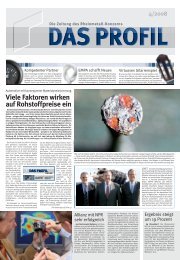
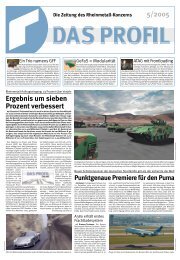
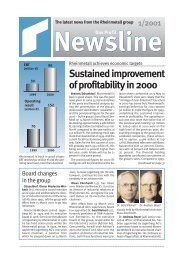

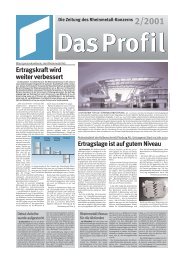
![PDF [1.0 MB] - KSPG AG](https://img.yumpu.com/5513074/1/171x260/pdf-10-mb-kspg-ag.jpg?quality=85)
